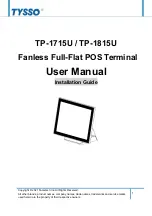
Product Description
18 / 94
EN-US · 30.30.01.02237 · 00 · 04/20
Option 2:
SUCTION = OFF after a communication interruption or restart of the SCTSi via rising edge at bit:
Ejector blow-off
True
false
True
false
ON
OFF
ON
OFF
EJECTOR CONTROL
/ Bit: Ejector suction
EJECTOR CONTROL
/ Bit: Ejector blow-off
“Suction” state
“Blow-off” state
ETH communication failure or supply
voltage failure of the sensor voltage SCTSi
Undervoltage for Ejector Variant IMP
In contrast to a power failure or communication interruption, the suction command is reset in the event
of undervoltage (without restarting the terminal) as soon as the supply voltage is in the permissible range
again and Bit = false is present on the suction ejector.
True
false
True
false
ON
OFF
ON
OFF
EJECTOR CONTROL
/ Bit: Ejector suction
EJECTOR CONTROL
/ Bit: Ejector blow-off
“Suction” state
“Blow-off” state
Undervoltage (sensor or actuator voltage)
The blow off valve on the ejector is activated and deactivated using the blow off command. The valve is
always designed as an NC (normally closed) variant and switches the air pressure channel to the vacuum
connection for the duration of activation. If both suction and blow-off are activated, blow-off is given
higher priority and the venturi nozzle is not activated.
If the ejector is in blow-off mode when the power supply fails, the blow-off is stopped and the ejector is
set to “pneumatically OFF”. This prevents unnecessary consumption of compressed air, thus saving energy
and additional costs. When the power supply returns, the ejector remains in “pneumatically OFF” mode.
If communication of the higher-level bus system (Profinet, Ethernet/IP, EtherCAT) is inter-
rupted, the ejectors retain their last activated state of suction, the neutral position or blow-off.
















































